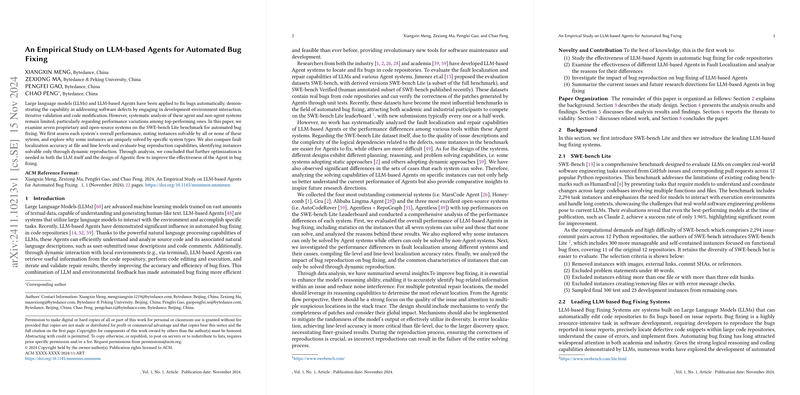An Empirical Study on LLM-based Agents for Automated Bug Fixing
The paper "An Empirical Study on LLM-based Agents for Automated Bug Fixing" offers a rigorous evaluation of LLM-based agents in the domain of automated bug fixing across code repositories. The paper contributes a comprehensive analysis of the performance of various systems, both proprietary and open-source, using the SWE-bench Lite benchmark. This benchmark evaluates the systems on real-world software defect datasets, providing a robust platform for assessing automated bug-fixing capabilities.
Systematic Assessment of LLM-based Agents
The paper investigates seven systems that employ LLMs—a mix of commercial (MarsCode Agent, Honeycomb, Gru, and Alibaba Lingma Agent) and open-source systems (AutoCodeRover, Agentless + RepoGraph, and Agentless). The systems are scrutinized based on their ability to interact with the development environment, execute iterative validation, and apply code modifications to fix bugs.
Key Contributions and Findings
- Comparative Performance Analysis: The systems were evaluated for their ability to successfully fix bugs across 300 test cases from SWE-bench Lite. MarsCode Agent emerged as the top performer with a 39.33% issue resolution rate, though the performance varied significantly among systems, highlighting differences in handling problem-solving tasks. The analysis suggested that higher issue resolution often correlates with more accurate and nuanced fault localization.
- Fault Localization Metrics: Fault localization is critical for effective bug fixing. The paper reports variations in localization accuracy, particularly highlighting the importance of line-level localization over file-level localization for achieving successful bug fixes. MarsCode Agent, given its multi-layered approach integrating code graphs, LLMs, and software analysis, achieved superior results. In contrast, some systems demonstrated strong line-level localization, correlating with better patch generation success.
- Role of Reproduction: Bug reproduction was found to be a key component in verifying and diagnosing defects, especially when issue descriptions lacked detail. However, the reliance on reproduction also presented challenges. Systems implementing reproduction methods sometimes experienced misguidance due to extraneous data derived from reproduction attempts, signaling the need for improved design strategies to handle such data reliably.
Implications of the Findings
The implications of these findings are twofold—practical and theoretical. Practically, insight into the need for enhanced reasoning capabilities in LLMs and careful design of agentic interaction flows can lead to improved system designs for better automated bug fixing. Theoretically, this reinforces the pursuit of more intelligent systems capable of nuanced fault localization and handling multiple, potentially erroneous, reproduction data sources.
Speculations on Future Directions
Future developments in AI for software engineering could see an increased integration of more sophisticated reasoning abilities within LLMs, paired with better contextual understanding and environmental feedback mechanisms. Additionally, more refined agent designs that incorporate advanced reconciliation methods for discrepancies in reproduction results could further boost the efficacy of automated bug-fixing systems.
The paper presents a detailed and thoughtful evaluation of current systems, promoting a deeper understanding of how LLM-based agents can evolve to overcome designated challenges in automated software maintenance. It also hints at promising directions for research and improvement, ensuring digital robustness and efficiency in providing automated solutions to complex programming errors.
